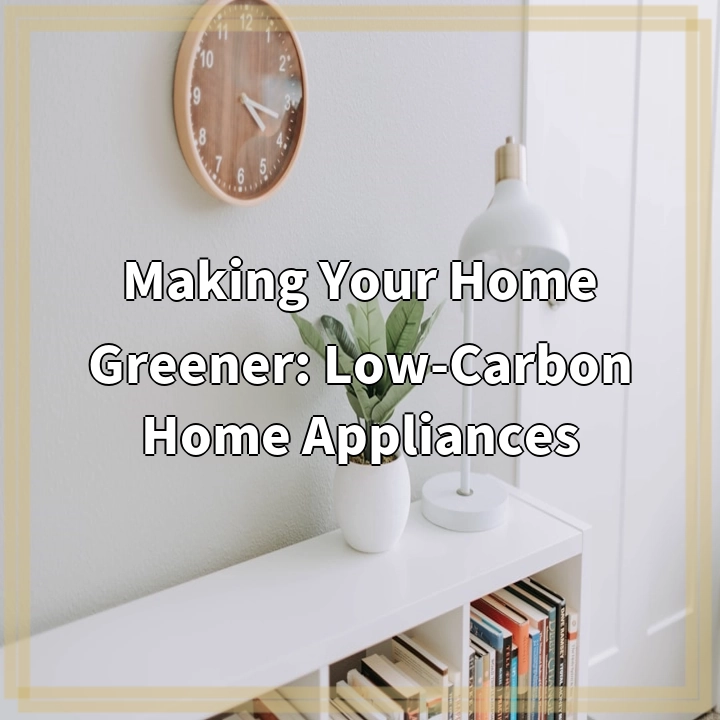
What it is:
In today’s world, where environmental sustainability has become a pressing concern, finding ways to make our homes greener is crucial. One effective method is by investing in low-carbon home appliances. These appliances are designed with advanced technology and energy-efficient features to reduce carbon emissions and minimize the environmental impact.
Real-World Problems:
While low-carbon home appliances offer numerous benefits, there are still some challenges and issues associated with their adoption. One of the primary problems is the initial cost. Often, these appliances come with a higher upfront price compared to traditional ones. This can deter people from making the switch, especially if they are on a tight budget or do not fully understand the long-term savings they can achieve.
Another problem is the lack of awareness. Many consumers are not familiar with low-carbon home appliances or do not fully understand their benefits. This lack of awareness leads to a limited market demand, which in turn hampers the growth and production of these appliances. It becomes crucial to educate consumers about the environmental advantages and potential long-term cost savings associated with using low-carbon home appliances.
Additionally, there may be compatibility issues with existing home infrastructure. Some low-carbon appliances require specialized installation or unique electrical connections, which may not be easily accommodated in older homes or buildings. This can pose a challenge for those looking to upgrade their appliances while maintaining the integrity and safety of their homes.
Furthermore, the availability and accessibility of low-carbon appliances may be limited in certain regions. In some areas, the market may not offer a wide range of options or adequate supply, making it difficult for consumers to find and purchase these appliances. This creates inequities in access to greener technologies and inhibits broader adoption.
Lastly, the durability and performance of some low-carbon appliances may still be a concern. As these technologies continue to evolve, there can be variations in the quality and reliability of different brands and models. Ensuring that low-carbon appliances are durable, efficient, and long-lasting is essential to build trust and encourage widespread adoption.
Despite these real-world problems, low-carbon home appliances offer a viable solution for reducing carbon emissions and making our homes more sustainable. By addressing these challenges through awareness campaigns, financial incentives, and improved product availability, we can overcome barriers and create a greener future for our homes and the planet.

Summarizing the Solutions:
Despite the challenges associated with low-carbon home appliances, there are several solutions to encourage their adoption and overcome barriers.
1. Financial Incentives:
Governments and organizations can provide incentives such as tax credits, rebates, or subsidies to make low-carbon appliances more affordable. These initiatives can help offset the initial higher costs and make them more accessible to a wider range of consumers.
2. Awareness Campaigns:
Educating consumers about the environmental benefits and long-term cost savings of low-carbon home appliances is crucial. Awareness campaigns through various mediums, including social media, websites, and educational programs, can help increase understanding and drive demand for greener technologies.
3. Infrastructure Upgrades:
Encouraging home infrastructure upgrades that are compatible with low-carbon appliances can address compatibility issues. Providing information and resources to homeowners about electrical connections, plumbing requirements, and installation processes can help create a smoother transition to more sustainable appliances.
4. Market Expansion:
Expanding the availability and accessibility of low-carbon appliances is vital. Governments and manufacturers can work together to ensure that a wide range of options is readily available in all regions. This may involve creating partnerships, incentivizing production, or improving distribution channels to reach underserved markets.
5. Quality Assurance:
It is crucial to establish quality standards and certifications for low-carbon appliances. Ensuring that these appliances are reliable, efficient, and durable will build consumer trust and confidence in the long-term benefits of investing in green technologies.
By implementing these solutions, we can overcome the challenges associated with low-carbon home appliances and accelerate the transition to a greener and more sustainable future for our homes and the environment.















